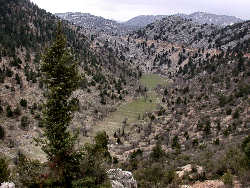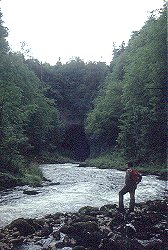Polje
A large closed depression, draining underground, with a flat floor across which there may be an intermittent or perennial stream.
The polje may be liable to flood and become a lake, and its floor makes a sharp break with parts of surrounding slopes.
Glossary of Speleological and Caving Terms, Australian Speleological Federation Inc. 1998

 Turkey.
Turkey.
 Rakov National Park
near Postojna in
Rakov National Park
near Postojna in
 Slovenia.
Slovenia.
A Polje is a valley whose walls are relatively steep but whose bottom is more or less flat. This term, like so many others, comes from the Dinaric Karst, the word means the same in Croatian, Serbian and Slovenian, namely field. The flat bottom of the Polje is usually a fertile plain, where farming is very easy, unlike the surrounding barren hills of the Karst. So here is a list of typical characteristics:
- The valleys are rather small (for valleys), a few hundred meters wide and typically one or two kilometers long.
- The sides of the valleys are rather steep.
- There is a stream flowing from one end to the other, not necessarily the whole year.
- The stream enters the valley in a karst spring, often a resurgence, the entrance to a cave.
- The stream leaves the valley in a ponor or swallow hole which also is the entrance to a cave.
- And last but not least: the valley has a flat and very fertile ground, a result of frequent flooding.
They can usually be clearly distinguished from dolines or sinkholes, mainly due to their size and the presence of an above-ground flowing stream. The polje is very often flooded because the swallow holes do not absorb the water when the water is poured out in large quantities or are blocked by trees. And finally: not every place which is named polje is a polje.
The classical polje were created tectonically. By orogenic movements limestone and waterproof flysh were transported to the same sea level. At the boundary of the areas is therefore a fault zone where the two blocks of rock have moved past each other. This is the reason for the different solubility and the change between Polje and Karst. A tectonic formation has to be determined by exact geological investigation. There are also other forms of polje, but geologists do not quite agree on what exactly a polje is. We will therefore base our definition on the above mentioned, which is based only on morphology.
- Examples
 Bamei Polje
Bamei Polje Polje de Mira-Minde
Polje de Mira-Minde Cerknisko Jezero or Cerknica Lake
Cerknisko Jezero or Cerknica Lake Planinsko polje
Planinsko polje Radensko polje
Radensko polje Rakov Škocjan Nature Reserve
Rakov Škocjan Nature Reserve
 Search DuckDuckGo for "Polje"
Search DuckDuckGo for "Polje" Polje - Wikipedia (visited: 10-JUN-2020)
Polje - Wikipedia (visited: 10-JUN-2020)
 Index
Index Topics
Topics Hierarchical
Hierarchical Countries
Countries Maps
Maps